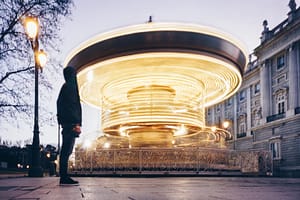Bicycle
Lots of people zip around town on motos (mopeds) and bike lanes are increasingly a part of the inner city’s thoroughfares. Be aware, however, that the latter are relatively new and few drivers are accustomed to keeping an eye out for cyclists.
You can transport your bicycle on the metro all day on Saturday and Sunday, and at any time from Monday to Friday except 7.30 am to 9.30 am, 2 pm to 4 pm and 6 pm to 8 pm. You can also take your bike aboard cercanías (local trains to suburbs) at any time.
BiciMAD
Madrid has publicly available electric bicycles that have recently become accessible for travellers. Called BiciMAD, the scheme has more than 1500 bikes available from 120 stations around the capital. While the system of annual subscriptions (abonos; €15 to €25) will most likely appeal only to residents, it is also possible to rent for one or two hours. To rent in this way (as a usario ocasional) from one of the stations, choose a free card covering a one-, three- or five-day period. To secure the card, you pay a €150 deposit with a credit card – this amount is then adjusted according to how much you’ve used the bikes at the expiration of your card. Rentals are for a maximum of two hours at a time.
Hire
Bike Spain Bicycle hire plus English-language guided city tours by bicycle, by day or (Friday) night, as well as longer expeditions.
Trixi.com Bicycle hire and cycling tours of central Madrid.
Bike & Roll Rents out bikes close to the Estación de Atocha.
DiverBikes Rentals just across the road from the northeastern corner of El Retiro.
Mi Bike Río Good choice for riding along the river; it’s a short walk down the hill from the royal palace or Plaza de España.
Bus
Buses operated by Empresa Municipal de Transportes de Madrid travel along most city routes regularly between about 6.30 am and 11.30 pm. Twenty-six night-bus búhos (owls) routes operate from 11.45 pm to 5.30 am, with all routes originating in Plaza de la Cibeles.
The Intercambiador de Autobuses de Moncloa has buses to many villages around the Comunidad de Madrid.
Car & Motorcycle
However you got to the city, avoid driving once you’re in Madrid if you can. The morning and evening rush hours frequently involve snarling traffic jams. They’re even possible in the wee hours of the morning, especially on weekends when the whole city seems to either be behind the wheel or in a bar. The streets are dead between about 2 pm and 4 pm, when people are either eating or snoozing.
Hire
Avis
Enterprise/Atesa
Europcar
Hertz
Metro
Madrid’s modern metro (www.metromadrid.es), Europe’s second largest, is a fast, efficient and safe way to navigate Madrid, and generally easier than getting to grips with bus routes. There are 11 colour-coded lines in central Madrid, in addition to the modern southern suburban MetroSur system, as well as lines heading east to the population centres of Pozuelo and Boadilla del Monte. Colour maps showing the metro system are available from any metro station or online. The metro operates from 6.05 am to 1.30 am.
Taxi
Daytime flagfall is, for example, €2.40 in Madrid, and up to €2.90 between 9pm and 7am, and on weekends and holidays. You then pay €1.05 to €1.20 per kilometre depending on the time of day. Several supplementary charges, usually posted inside the taxi, apply. These include: €5.50 to/from the airport (if you’re not paying the fixed rate); €3 from taxi ranks at train and bus stations; €3 to/from the Parque Ferial Juan Carlos I; and €6.70 on New Year’s Eve and Christmas Eve from 10pm to 6am. There’s no charge for luggage. Among the 24-hour taxi services are Tele-Taxi and Radio-Teléfono Taxi.
Train
The short-range cercanías (regional trains operated by Renfe) are handy for making a quick, north–south hop between Chamartín and Atocha train stations (with stops at Nuevos Ministerios and Sol), or for the trip out to San Lorenzo de El Escorial.

